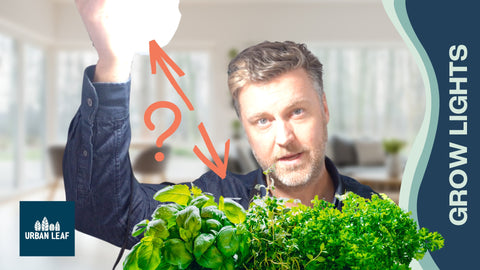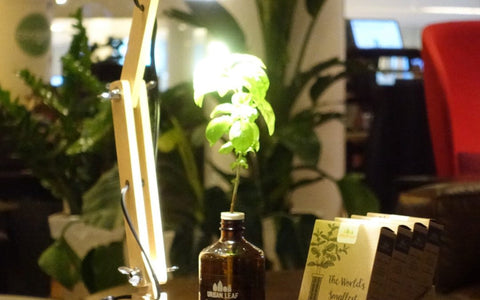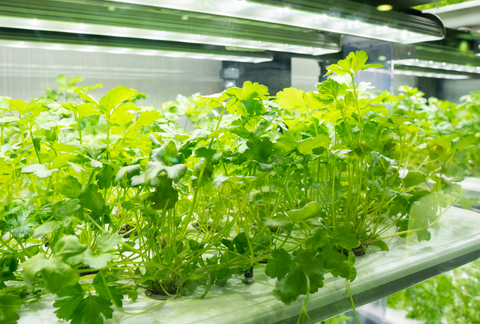How Far Should Your Grow Light Be From Plants?
Getting the placement of your grow light correct is super important for delivering the right amount of light to your indoor garden, and having happy indoor plants.
Depending on the type of light, and the plant you're growing, appropriate distances from plant to light can range from as little as two inches, up to two feet or more.
The goal of this blog is to help you understand the main factors that determine optimal grow light placement, so that your indoor garden can thrive.
How Plant Type Impacts the Correct Distance for Your Grow Light
Popular foliage plants, such as Ficus (fiddleleaf fig), Monstera (Swiss cheese plant), Philodendron, Anthurium, Calathea & Maranta (prayer plant), and ferns have a wide range of optimal light levels as well as ranges for surviving versus thriving. While prayer plants and ferns can survive and thrive at low light levels (i.e. a DLI of 3-4 Mol/m2/day), Monstera actually grow much better with medium light levels with a DLI between 10-15 Mol/m2/day, and sun lovers such as fiddle leaf fig really want a DLI of between 20-30 Mol/m2/day.
When you're growing vegetables and herbs indoors, such as lettuce, herbs and leafy greens you'll need to provide medium to high light conditions typically between 15-20 Mol/m2/day. And just like the sun loving indoor plants, flowering and fruiting edibles such as peppers and tomatoes also need "full sun" conditions with a DLI of 20-30 Mol/m2/day. Dwarf and miniature varieties produce well at the lower range of 20 Mol/m2/day while larger slicing tomatoes will need 30 Mol/m2/day.
Simply put; you'll typically place your grow lights:
- further away from low light plants, and
- closer to high light plants
How Wattage Impacts Grow Light Placement
Generally speaking, more watts (energy consumed) translates to more plant available light energy. But that always depends on the quality and efficiency of the individual grow light.
All else equal, higher wattage bulbs will be placed further from the plant and low wattage bulbs need to be placed closer. Note that some manufacturers attempt to mislead consumers by quoting an "effective" wattage. This is irrelevant for plants, and we recommend ignoring it. All of the Grow Lights we offer here at Urban Leaf include a handy comparison table so you can determine which one is right for you.
How Beam Width Impacts Grow Light Placement
You'll notice that some grow lights just have 'naked' or exposed LED chips, which are basically throwing light in all directions, while others emit a much more concentrated array of light - which results in a higher intensity of light, or PPFD (scroll down for all lighting definitions!) hitting the plant. This is usually achieved with some sort of reflector, light-concentrated lens, or optics. All else equal, a grow light with optics can be placed further away. The diagrams below will help make this point a bit clearer.

How Plant Maturity Stage Impacts Grow Light Placement
Plants at different stages of development will need different intensity (PPFD), light duration (photoperiod), and overall light quantity (DLI). Seedlings typically need a DLI of around 10-15 Mol/m2/day, which falls into the medium light category; but you'll typically need to place grow lights close to seedlings to prevent over-stretching. As the seedlings mature and begin growing true leaves you can raise your grow light.
As plants such as tomatoes mature and reach their flowering and fruiting phases they may need both a higher light intensity and DLI, which could mean your grow light is closer to plants and/or you run the lamp longer. Note, you should also consider a more powerful grow light for these sorts of applications such as an Aspect, Vita or PlantSpectrum.
Grow Light Placement for Lettuce and Leafy Greens
The chart below summarizes typical grow light placement for various types of E26 screw in grow lights.

Let's check out a couple of examples:
- If you have a ~10W grow light with a lens (like our compact grow light) then you'd want it 7-9" from the foliage.
- Or if you were using something more powerful like the Vita Grow Light (which also has optics) then 8.5 - 11" is going to be more appropriate.
Grow Light Placement for Fruiting & Flowering Plants
And here's the same chart for Fruiting & Flowering plants like peppers & tomatoes

You'll notice that the distances in this second chart are overall much closer. This is because of the higher light intensity these plants need. Grow lights without lenses/optics really don't make much sense here. At the 10W end of the chart you'll notice that the light would need to be within an inch or two in order to deliver enough light intensity. Since this is so close that you're likely to burn the leaves by touching them, we'd suggest you don't even bother trying fruiting plants if you're using this sort of light.
WANT TO BE A REAL PLANT NERD?
Learn about the specific light measurements, meanings, and acronyms
Grow Light Power (PPF)
PPF stands for Photosynthetic Photon Flux. This is the amount of useable light a grow light can emit per second, measured as umol/s. All grow lights perform a similar function; they convert Watts from your wall socket into PAR (photosynthetically active radiation) for the plants. PAR includes the spectrums of light a plant can use for photosynthesis. All grow lights are not created equal, however, and some are much more efficient at converting Watts into PAR, which we measure as PPF, than others. If we divide these numbers together we get PPF/W, PPE, or ‘efficacy’. Essentially how many umol of PAR you get for every Watt.
While PPF isn't something you can measure at home, it does determine the next measurement we'll cover, which is very important in determining the distance of your grow light. And, you can get an idea of how efficient your grow light is by looking at it's PPF/W or PPE on the label.
Grow Light Intensity (PPFD)
PPFD stands for Photosynthetic Photon Flux Density and it is measured in umol/m2/s. Essentially PPFD is the number of light photons hitting your plant canopy over a m2 each second. Simply put, this is the light intensity of your grow light. Think of full sun, part sun, shade exposure. In a full sun location more light photons will hit your plant. In a shady location fewer light photons will hit your plant.
The closer your grow light to your plant the higher the light intensity (PPFD). The farther away your grow light, the lower the light intensity (PPFD).
An easy analogy for PPFD is to think of your grow light as a sprinkler head. Just as sprinklers distribute water in multiple directions, grow lights do the same with light. If you stand right next to a sprinkler, you will get drenched pretty quickly with more drops of water (light photons in our analogy). But if you were further away, you might only feel a very subtle spray with fewer drops of water. The same concept applies to grow lights and photons of light.
When it comes to intensity, a sun-loving fiddle leaf fig and tomato plants would perform better much closer to the grow light, receiving a more intense "spray of water", or light photons...whereas your prayer plant or fern would probably fry at the same distance. You'd need to reduce the intensity for your lower light plant by moving the sprinkler head, or grow light, further away from the plants.

Grow Lights and Daily Light Integral (DLI)
Now, DLI or daily light integral, is the light measurement most important to your plant's overall ability to thrive. DLI is the plant worlds’ equivalent to us humans and our calories. If you don’t give them enough light energy each day, they will wither and likely die. Essentially, DLI is the total number of light photons your plant receives each day and we measure DLI as Mol/m2/day.
DLI is determined by the PPF of your lamp, the PPFD (distance of your grow light), and the amount of time you leave your lamp on over the course of a full day. You can increase your DLI by placing your grow light closer to your plant and by running your grow light for more hours.
Let's go back to our sprinkler analogy. Let's say you have a 10-gallon bucket (we'll equate that to a DLI of 10 Mol/m2/day) and you place a high pressure sprinkler 12-inches above the bucket (high intensity, high PPFD). The closer concentrated spray of water fills the bucket in 6 hours. Now, if you move the sprinkler head 3-feet away from the bucket with less water drops actually making into the bucket (lower light intensity, lower PPFD), it now takes 12 hours to fill the same 10-gallon bucket or reach the same DLI of 10 Mol/m2/day.
BUT...some plants are photoperiodic and will either flower or not flower depending on how long you light them (photoperiod). So timing can get a little more complicated depending on what plants you're growing. We'll explain that a bit more in the next section.
Grow Light Distance Is Impacted by Grow Light Timing
So let's talk about timing your grow light since it influences both your DLI and developmental changes in your plants such as flowering. As we discussed in How Long Should You Leave Grow Lights On For?, all plants have an optimal duration of light called the photoperiod – that will either encourage or discourage flowering. For example longer photoperiods (more than 12 hours) will trigger certain plants, such as lettuce, to flower. It can also cause herbs such as basil flower faster. This may not be desirable in either case. Conversely, you may want your plants such as tomatoes, cosmos, orchids, or cannabis to flower, which may require shorter or longer days. So, how do you decide how long to leave your grow light on? Take into account these four key factors:
- The total volume of light that your plant needs to be happy (DLI)
- the light intensity your plant needs or can tolerate (PPFD)
- the ideal time/duration you'll need to hit your target DLI at that PPFD, and
- any photoperiod requirements your plant has for flowering/flowering inhibition.
In our accompanying article titled How Long Should You Leave Grow Lights On For?, we include a comprehensive list for edible plants, but if you’re looking for an approximate range then most edible plants will require 10-30 Mol/m2/day.
Which Grow Light Is Right For You?
If you’ve made it this far, well done! We have hours (if not days!) worth of additional content on Grow Lights across our website and YouTube channel. The best way to navigate through it all is from the learn page.
If you'd rather skip that, and just go straight to selecting from a range of high quality grow lights vetted by our expert team, then here's a few pointers to get you started:
- Best Hanging Option: If you have a wall or ceiling from which to hang your light, then the Aspect grow light is the way to go. It comes in white and black, as well as 20W or 40W.
- Best Free Standing Option: If you'd rather not be drilling holes in your ceiling/wall, then a great alternative is to get a free standing option like the PlantSpectrum. The small is 16" and 16W, and large is 32" and 32W. They are not only incredibly versatile in terms of mounting options, but they have the added benefit of being water proof.
- Best Under-Cabinet Option: If you're looking to grow on a bookshelf or countertop, then you should definitely check out the Grove. It has a number of mounting options (like the PlantSpectrum) and comes in at a more affordable price point.
- Most Versatile Option: If you live in a rental, move around a lot, or just want future flexibility - then a Vita is your best bet. This is available as both a stand-alone globe, as well as in a pendant kit. We also offer options in black/white and narrow/wide beam angle. It's E26 fitting is compatible with any standard screw-style housing (i.e. desk lamp, lamp stand, or pendant light).
- Best Budget Option: If you're just looking for something cheap and simple for seed starting or a single herb plant, then we do also offer a compact option. This unit is not suitable for large grow areas or fruits/vegetables, however.
You can also grab a FREE copy of our Comprehensive Grow Light eBook here.








Hello. My neighbour has placed at roof level, 2 outdoor LED lights, the spotlight variety. I don’t know the wattage, but it is high, as we get some light through our 2nd storey windows, which are located about 40 ft. from these lights. . We have empirial oak trees and confifers at the property line. These lights are about 20 ft. from the property line. I am very concerned these LED lights, which are left on all night, will damage our trees. Should I be worried?
An early response is very much appreciated.
What distance do I need to put my 75 watt full spectrum light from my auto flower cannabis plant in all stages of growth
What distance doing need to put my 75 watt full spectrum light from my auto flower cannabis plant from seed to flowering
What distance do I need to put my 75 watt full spectrum light from my auto flower cannabis plant in all stages form seed to harvest what the best distance for my plant
I would like to see more detail regarding indoor plants such as Christmas Cactus, philodendron varieties, draceana, snake plant, and pothos ivy. Your articles give ample information for fruits and vegetables, but near enough for indoor plants.
please, i wrote everything in your chat box. with the bulbs i have…how close to the plants do i put the bulbs and how long do i leave them on for?
CHAT
i have 2 Monstera plants. they are big. together (side by side) the canopy of leaves measure 9’ across and 7’ deep. the plants stand on the floor. the surface of the leaves are all at the same height 4’6", from the floor. the plants are NOT dense because if i tied the leaf stems together, the 24" leaves would be crushed and destroyed.
i have 2 standing floor lamps with 1 grow bulb in each. how far away should the bulbs be from the Monstera canopy? the bulbs are
20 PAR/PPF umol/s
PPF efficacy….1.25
16 Watts…“full spectrum LED grow light”
luminous flux lm…900
CCT…3500
CRI (Ra) …80
range nm………………………..Photon Flux
500-599 5.1 600-700 11.1umol/s
400-499 3.8
I am starting tomato seedlings in hydroponic solution and wonder how far the grow light should be from the plant
Thank you for your article. Einstein said, If you can’t explain something simply, you don’t understand it yourself. You used some great analogies, so well done, I feel ready to tackle my salad growing project in a basement without natural light. I am sure that I am going to learn loads and have fun at the same time.
Have a good day
Cheers
Leigh
What is the distance a plant should be for a 40 watt grow light ????
42 watt full spectrum led light fixture
Do you know the PPFD